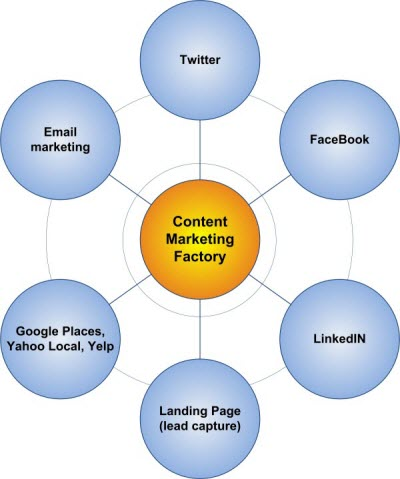Inbound Marketing vs Outbound Marketing Go Head to Head in Petaluma
By Jaco Grobbelaar on Tue, May 27, 2014 @ 07:48 AM

 In the spirit of a recent article I wrote, What Does “Inbound Marketing" Mean for Petaluma? [Video], I have located 3 articles that I have turned into boxing rounds about inbound vs. outbound marketing. It’s time for a boxing match to see which will kiss the canvas and which will be the winner. The winner becomes the champion marketing method for business people here in Petaluma and anyone else who is sitting on the fence.
In the spirit of a recent article I wrote, What Does “Inbound Marketing" Mean for Petaluma? [Video], I have located 3 articles that I have turned into boxing rounds about inbound vs. outbound marketing. It’s time for a boxing match to see which will kiss the canvas and which will be the winner. The winner becomes the champion marketing method for business people here in Petaluma and anyone else who is sitting on the fence.
Round 1
First we will get some simple information from Ramesh Ranjan from his article Outbound Marketing Vs. Inbound Marketing: An Honest Comparison.
Ramesh offers an honest and fair comparison for people to make up their own minds. His definition of outbound marketing is:
...a one-way street - you connect with your audience by placing ads, sending direct mail and making cold calls. Don’t let the connotation of the first part of that sentence bring you down, if you indeed use outbound marketing. Outbound marketing has worked for companies in the past and is how many businesses continue to drive sales today.
Ramesh says the benefits of outbound marketing are that people are used to it. The reach can be enormous, cold calling really works and so does direct mail. +4 points
The drawbacks include the fact that people don’t like being interrupted. Plus their time is precious and commercials are not. Furthermore, basic reporting data is not easily accessible to the organization. You can guestimate the number of viewers, but you can’t know if it lead to a conversion. -3 points
Ramesh defines inbound marketing
Inbound Marketing is a method of getting visitors to find your business through search engines (paid and organic results), social networks and special content offers. The purpose is to attract them to your website, convert them into interested leads, and move them down your sales funnel so that they become not only paying customers, but evangelists for your brand.
Here in Petaluma inbound marketing’s benefits are that it builds trust, people like the content and appreciate the educational information. Ramesh called on this statistic: +3 points
According to the Content Marketing Institute, 80% of business decision makers prefer to get product information in a series of articles rather than an advertisement. People also like to do this on their own time - without pressure from a telemarketer, salesman or direct response ad.
That is powerful.
However the only drawback of inbound that Ramesh has includes the fact that not everyone is looking for what the inbound marketer is offering. -1 point
(We have to confess that Ramesh is biased toward inbound marketing.)
Ding! Ding! Ding!
The bell signals the end of round 1, the boxing match between inbound marketingand outbound marketing taking place in Petaluma.
Tallying up the points we see inbound marketing is ahead with 2 points whereas outbound marketing ended the round with a 1.
Round 2
We have Mike Waterston offering this article Paradigm Shift: Outbound vs. Inbound Marketing. From the start we know that Mike doesn’t like television advertising. And he is not alone. He mentions all the people who record a show just so they can skip through the ads. These are the same people who don’t buy newspapers, but get their news from their smartphones and prefer listening to Sirius radio that is ad free. So we already know which side Mike is taking.
Mike says that marketers need to face the fact that consumers have changed the way they consume and marketers need to change along with their clients. We have yet another set of definitions. Mike starts by saying:
The old standard, outbound marketing is the process of actively pushing your message out to consumers, and typically involves casting the largest possible net in the hopes that your broad message will resonate with as large a segment of the viewers as possible. This usually consists of tactics like mass media ads, direct mail campaigns, cold-calling, and trade shows. While certainly still effective when employed correctly, these tactics may not be the right choice for your brand.
He has just 2 pros for outbound: there is enormous exposure and an organization can set it and forget it, making for very low maintenance. +2 points
Against outbound Mike mentions the facts that these ads are untargeted. You many have many views, but have you reached your market. Next he says that outbound is untraceable. How many of those views visited an organizations store or went on in because of the ad? Who knows? The last of his drawbacks is a big one--the cost. These ads are very expensive and it is not really possible to know ROI for that campaign, guestimates again. -3 points
Now let’s turn to Mike’s clear favorite, inbound. He defines it as
…inbound marketing aims to attract consumers by providing them with the personal, customized content that they seek. Blog and social media content are key to luring your audience and giving them a reason to choose your brand over the competition. The ability to target and track your content means a boost in cost-effectiveness, but it also requires more time and energy from your team.
Mike has 3 pros including the fact that inbound allows an organization to be seen on multi-channels, by targeting the people you want to reach the consumer feels like the business is talking directly to him or her and inbound marketing is integrated with digital media analytics allowing the business person to trace, analyze and edit the content. +3 points
Drawbacks are that inbound marketing reaches smaller audiences and that it is high maintenance. You have instant information about how a campaign is going and you have to change strategies. -2 points
Mike ends by saying that many brands have a combination and just need to decide on what percentage of the marketing budget goes to each.
Ding! Ding! Ding!
That concludes round 2 and here we have a split draw, ladies and gentlemen. The judges have declared this bout even.
The score of the match so far is 1 for inbound marketing and a draw for outbound.
The crowd here in Petaluma are hushed, wondering how this will play out.
Round 3, our last and final round
The article we will be looking at is Ad Realities: Outbound vs. Inbound Marketing by Andy Donovan. Andy doesn’t spend much time on definitions and I think we all have the point now anyway.
He rushes into drawbacks for outbound without offering even token benefits.
Andy says that outbound is very high budget spending. While this might be alright with large organizations it is a reach for medium or small ones. Next we see that problem with calculating ROI.
Andy says that “The definition of KPIs and the process of granular data measurement and analysis are generally had to handle.” And his last drawback is TiVo and how people are intentionally using it not just because they can watch a show when they have time, but they can also zip through the ads. No surprises here. -3 points
Let’s look at what Andy has to say about inbound marketing. Here again Andy skips right past any negative aspects and gives four pros about inbound. We have had two of these already but the third and fourth make a big difference.
Inbound marketing facilitates a more precise ROI calculation. (I have to add here the Hubspot makes this process extremely easy to do. Since I am Hubspot Academy Inbound Certified, we can talk about this later.)
Next Andy says that inbound doesn’t require excessive spending.
The third benefit takes over where Mike just touched. Mike said that consumers feel like messages are personalized. By targeting the people you want to reach the consumer feels like the business is talking directly to him or her.
Andy takes this much farther:
It (inbound) enables businesses to drive engagement and generate demand naturally, without irritating potential or existing clients.
And finally Andy says
... if a company analyses the target market, it will find out where the potential clients like to browse including social media like Facebook, Twitter and LinkedIn. Using these channels instead of television channels, a business can promote their products much more efficiently. +4 points
What's this, ladies and gentlement? Outbound has hit the mat. It looks like it has been knocked out!
 Ding! Ding! Ding!
Ding! Ding! Ding!
The bell signals the end of the final round. In this one round inbound marketing is the winner with 1 point.
And our boxing match between inbound marketing vs. outbound marketing shows that inbound marketing is the clear winner with a 2-0 score. The crowd favoring inbound marketing in Petaluma are cheering wildly.
I have to confess that all these articles came from inbound marketing specialists and I am one, too. But the defining point is that inbound marketing brought you this match. Inbound marketing encourages marketers to send messages without the old one-two punch of outbound. So if you are sitting on a fence, I encourage you to look at these three articles, brought to you by inbound marketing.
Image: Shutterstock by AntonioDiaz
 Jaco Grobbelaar is the owner of BroadVision Marketing. BroadVision Marketing works with business owners to put in place inbound and outbound marketing strategies that consistently secure new clients. The BroadVision Marketing Training Center is located in Petaluma, CA and primarily serves companies in the San Francisco Bay area.
Jaco Grobbelaar is the owner of BroadVision Marketing. BroadVision Marketing works with business owners to put in place inbound and outbound marketing strategies that consistently secure new clients. The BroadVision Marketing Training Center is located in Petaluma, CA and primarily serves companies in the San Francisco Bay area.
Jaco can be reached at jaco@broadvisionmarketing.com or 707.766.9778 or connect with Jaco on Facebook - www.facebook.com/broadvisionmarketing - and LinkedIn - www.linkedin.com/in/JacoGrobbelaar. He can also be found at Jaco+.
You May Also Like
These Related Stories

How Can an Inbound Marketing Coach Can Help?

Marketing Help—Know Your Target Market

.png?width=302&height=75&name=BVM%20Logo%20-%20transparent%20(1).png)


No Comments Yet
Let us know what you think